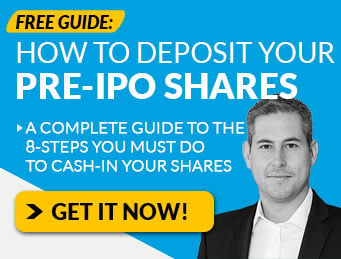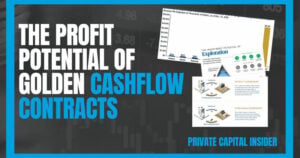Over the weekend, we talked about how the current banking crisis could impact the commercial real estate (CRE) sector in the next 12-24 months.
But as we learned from Blackstone’s CEO, not all CRE is created equal.
For those who are interested in diversifying into private real estate deals, today’s email will serve as Part 1 of a multi-part series on how the Equifund team analyzes real estate opportunities in today’s market conditions.
Let’s dive in,
Jake Hoffberg
P.S. We appreciate that for many people, their life savings is not a game.
However, we choose to present our investor education as a game, because the purpose of games is to develop key skill sets you can use in the real world (and hopefully have fun along the way).
As a reminder, securities sold under Reg CF, Reg A, and Reg D are often considered high risk, and speculative in nature. Please do not invest funds you cannot afford to lose, or otherwise need immediate access to invested capital.
How People REALLY Become Millionaires (and Billionaires) in One Generation
You’ve probably heard the famous quote about real estate often attributed to Andrew Carnegie…
“Ninety percent of all millionaires become so through owning real estate. More money has been made in real estate than in all industrial investments combined. The wise young man or wage earner of today invests his money in real estate.”
While I can’t exactly summon the ghost of Carnegie to defend this statement with data, there are two problems with this claim.
$1m in 1900, when Carnegie was still alive, is roughly $35m in today’s dollars (called “Ultra High Net Worth” or UHNWI by today’s standards).
There are no studies confirming that real estate is responsible for creating 90% of all millionaires then, or now.
But good news. There’s plenty of recent research that explores how millionaires might acquire – and keep – their wealth in modern times.
The data seems to suggest pretty much anyone can achieve “Millionaire Next Door” status ($1m-$5m net worth) given enough time and effort.
On average, it takes ~18 years for Americans to earn $1 million before tax and ~65-68 years to become a millionaire.
For those who have built a $5m+ net worth, business ownership is most often how they achieved it (although, those businesses could be real estate related).
But what about the multi-millionaires and billionaires?
According to the Wealth-X 2022 Billionaire Census, the richest people in the world built their fortunes via banking and finance.
That’s why at Private Capital Insider, we are far more interested in understanding how finance professionals – like investment bankers and private equity firms – invest, compared to everyone else.
And that’s why today, we’re going to discuss the Private Equity Playbook for investing in private real estate opportunities.
How Private Equity Makes Money in Real Estate
As a retail investor, you typically have two options for getting exposure to real estate in your portfolio.
Become a Landlord: This means directly investing in individual properties and assuming responsibility for the management of the asset.
Invest in Real Estate Investment Trusts (REITs): A REIT is a company that owns – and typically operates – income-producing real estate or real estate-related assets.
For the sake of this article, I’m going to assume that you don’t want to be a landlord, and would rather have an equivalent (or better) return as a passive investor.
REITs provide a way for individual investors to earn a share of the income produced through commercial real estate ownership – without actually having to go out and buy commercial real estate.
Unlike other real estate companies, a REIT (generally speaking) does not develop real estate properties to resell them.
Instead, a REIT buys and develops properties primarily to operate them as part of its own investment portfolio.
The income can either come from rent generated by real assets (e.g., apartment or commercial buildings), or interest payments generated by real estate-related debt (e.g., mortgages).
This means if we’re going to consider ANY form of passive real estate investing strategy, the expected returns should be better than what we could reasonably expect in publicly traded REITs.
Publicly traded REITs (also called exchange-traded REITs) have their securities registered with the SEC, file regular reports with the SEC, and their securities are listed for trading on an exchange such as the NYSE or Nasdaq.
As with any stock listed on an exchange, you can buy and sell shares of a publicly traded REIT with relative ease.
Because private REITs do not have the same liquidity as public REITs, owning a minority stake in a private real estate deal is tough to justify, unless we’re getting a better risk-adjusted return.
According to data from JP Morgan, REITs were the best-performing asset class between 2001 – 2020, yielding a 10% annualized return, compared to the average investor’s 2.8% return (OUCH!).
Most REITs specialize in a single type of real estate. However, some REITs – like the Blackstone REIT – have multiple assets in their portfolios.
According to the Green Street Commercial Property Price Index, self-storage facilities, warehouses, and manufactured housing communities have outperformed every other real estate format by a wide margin.
Source: Green Street Capital
While there are plenty of Publicly Traded REITs to choose from, there is a vast universe of Private REITs – and other private real estate formats – that are becoming more widely available to retail investors.
But unlike publicly-traded REITs, private real estate investment opportunities often come with complex fee structures that may negatively impact your returns.
Here’s a quick primer on how these products might be typically structured.
The GP/LP Fund Structure Explained
If you decide to invest in any private real estate as a passive investor, chances are, you’re doing it through some sort of fund structure.
These funds are standalone investment vehicles that are managed by a Private Equity firm (known as General Partners or “GPs”) on behalf of a group of investors (known as Limited Partners or “LPs”)
Source: Mastering Private Equity
Understanding this structure is crucial for investors considering an allocation to private equity real estate funds, as it plays a significant role in determining the distribution of profits, risks, and responsibilities among the parties involved.
In a typical GP/LP fund structure, profits are distributed according to a predetermined formula called the “waterfall.”
Source: Mastering Private Equity
These waterfalls can range from “simple and straightforward” to “weird and complex.”
However, generally speaking, it typically works as follows.
Step 1) Return of Capital: The first tier in the waterfall is the return of capital to the LPs. Before any profits are distributed, the LPs’ initial investment will be returned.
This ensures that the LPs are prioritized in recouping their investment before any other allocations are made.
Step 2) Preferred Return: The second tier is the preferred return, also known as the “hurdle rate.” This is a predetermined percentage return on the LPs’ investment, which must be achieved before any profits are shared with the GP.
Preferred returns might range from 6% to 10% annually (typically), depending on the risk profile of the fund and market conditions. Until this return is met, the LPs will receive 100% of the profits.
Step 3) Catch-up Provision: Some funds include a catch-up provision, as the third tier in the waterfall structure. This provision allows the GP to receive a portion or all of the next profits, until they have caught up with the LPs in terms of the preferred return.
For example, if the catch-up provision is set at 100%, the GP will receive all profits until their share of the total profits equals the same percentage as the LPs’ preferred return.
Step 4) Carried Interest or Performance Fee: Once the preferred return and catch-up provision (if applicable) have been satisfied, the remaining profits are split between the GP and LPs, according to an agreed-upon ratio, often referred to as the “promote” or “carried interest.”
This ratio is typically in the range of 80% for LPs and 20% for the GP, but can vary depending on the specifics of the fund. This tier ideally aligns the interests of the GP and LPs, incentivizing the GP to maximize returns for the benefit of all parties.
But that doesn’t mean these are the only ways the GP (or related parties) can extract returns at the expense of the LPs.
Some of these fees may not be explicitly stated in the fund’s documentation, or they might be buried in the fine print.
Here are some common hidden fees to be aware of when investing in private real estate funds:
Transaction Costs: According to the SEC, “typically, fees of 10-15 percent of the investment are charged for broker-dealer commissions and other up-front costs. Ongoing management fees and expenses also are typical. Back-end fees may be charged.”
Management Fees: Often 1-2% of the total capital paid into the fund, per year, goes to the management team.
Acquisition Fees: Some funds charge fees related to the purchase of properties, which could include due diligence costs, legal fees, and other expenses related to the acquisition process. These fees may be charged as a percentage of the purchase price or as a flat fee.
Asset Management Fees: In addition to the management fees charged by the fund, there may be separate fees associated with managing the individual properties within the portfolio. These fees may be charged as a percentage of gross or net income, and can vary depending on the type of property and level of management required.
Disposition Fees: When a property is sold, the fund may charge fees related to the sale, such as broker commissions, legal fees, and closing costs. These fees can reduce the net proceeds from the sale, impacting investor returns.
Financing Fees: Some funds charge fees related to obtaining financing for property acquisitions, such as loan origination fees, commitment fees, or underwriting fees. These fees can increase the overall cost of borrowing, potentially impacting the fund’s returns.
Development or Construction Fees: If the fund is involved in property development or significant renovations, there may be fees related to construction management, permitting, or other development-related costs. These fees can add to the overall cost of the project, impacting the fund’s returns.
Operating Expense Mark-ups: Some funds may mark up the costs of various operating expenses, such as property management, insurance, or maintenance services. These mark-ups can increase the overall operating costs of the properties, reducing net income and investor returns.
Organizational Expenses: Some funds charge fees related to the formation and operation of the fund, including legal, accounting, and administrative expenses. These fees may be charged as a percentage of committed capital, or as a flat fee, and can impact the fund’s overall performance.
Incentive Fees: In addition to carried interest, some funds may charge additional incentive fees based on the fund’s performance. These fees can reduce the overall returns available to investors.
To protect their interests, investors should carefully review the fund’s documentation, including the private placement memorandum, limited partnership agreement, and any other materials provided by the fund manager. It’s essential to understand the fee structure, ask questions, and seek professional advice if necessary.
Transparency and communication between the investor and the fund manager can help ensure a clear understanding of the fees involved, and their impact on overall returns.
What if there was a way to invest in a Private Real Estate strategy WITHOUT these fees?
Imagine for a moment that you had a chance to invest in Berkshire Hathaway (BRK) in its very first year.
For all intents and purposes, BRK operates the same way a fund does; they are in the business of acquiring shares of other companies (vs selling products and services directly to consumers).
However, because BRK is structured as a company – not a partnership or a fund – it’s kind of like investing in a private equity fund, but with zero fees or carried interest.
Needless to say, the returns Buffett and Munger have achieved over their career have been nothing short of extraordinary.
That’s not to say any “no fee” investment vehicle will always outperform funds that have them – However, from a purely mathematical standpoint, reducing “fee drag” is an easy way to increase potential returns without adding risk.
While this might not be a big deal for a venture capital-style investment that either returns 100x, or zero…
In real estate, every single percentage point makes a difference.
As always, do your own due diligence before investing in any private investment opportunity. Some Private equity funds are notorious for making it difficult to understand exactly how the fee structures work, and what the LPs can expect in actual returns.
If you can skip over all the brain damage of building a waterfall model in Excel, and invest directly into a real estate management company that has no fees…
The simplicity of the structure might make more sense for smaller retail investors who want to add private real estate to their portfolio.











